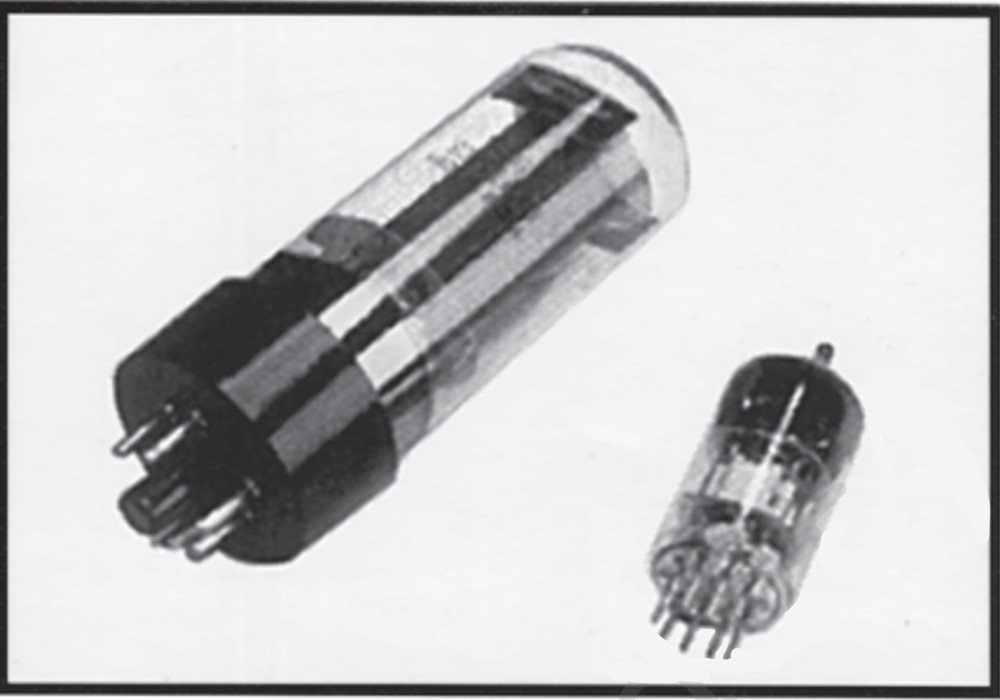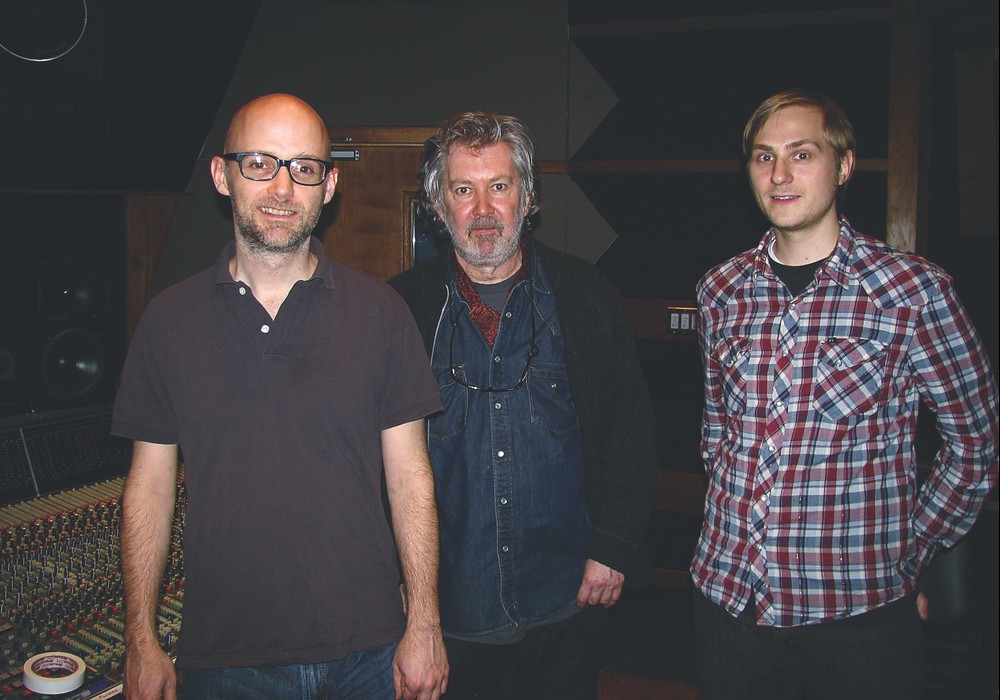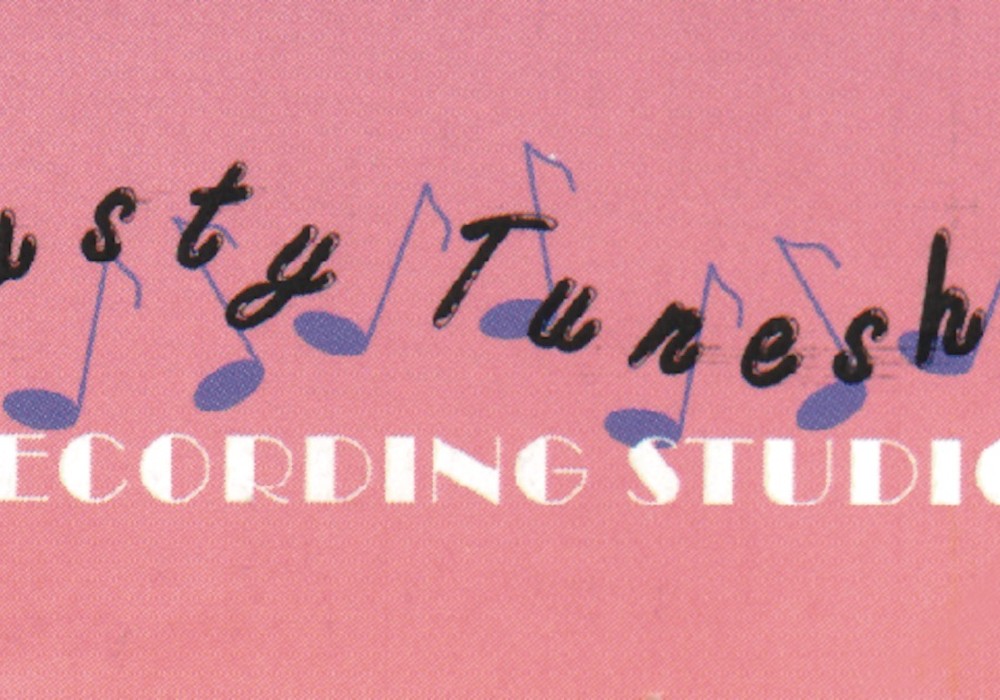There is nothing like remote recording. Studio recording is a bore by comparison. Think about it: You get to pack up all your heavy gear, carry it to your car, drive it some distance, load it out of your car, carry it up some steps and through a building until you can set it down in some location (a closet, hallway or toilet, for instance) that will become your new "control room". Once all the gear is in the building, you get to assemble it, test it, record with it and then take it down, pack it up and haul it home, where you carry it inside again. I tell my friends I am not in the music recording business. I am in the equipment moving business — and that is basically true. Yet, I wouldn't change it for anything.
Over the past thirty years I have gotten to travel to some wonderful locations (both near and far) and have met wonderful people making great music. Every project has a story associated with it and often photos to remember it by. That beats the heck out of staring at the same studio walls all day.
When I first started recording music on location very few people — by comparison, anyway — were doing it. Now it's seen by many novice recording engineers as a relatively cheap means of breaking into the music recording business. After all, you don't have to invest in a studio, just good gear, and then you record musicians where you find them! That's a very simple business model anyone can relate to. That was its appeal to me and it has largely held true. If this type of recording appeals to you, then here are some basic guidelines.
Your Philosophy: If you are just starting out, quickly write down on a sheet of paper what types of projects you want to do. Follow that with a list of the things you don't want to do but are willing to do. Lastly add those things that you would never do. This is all subject to change, of course, but it's a good start. Now outline your recording technique. This should be a listing of the mic techniques you would use and the types of gear you would need to carry out the projects you listed on the first page. Add in any necessary people to help you accomplish the recording. This page should now govern your whole recording business. For instance, excerpts from my page would include, "My projects will be classical, jazz and ethnic music recorded on location; the techniques include minimal mic'ing, extensive use of stereo pairs, minimal signal processing, the highest quality gear I can afford and great customer service."
Everything you purchase from now on should support your philosophy. You will now also need to be able to determine "need" from "want". There are many things you need to run your business. Don't confuse them with the things you want but don't need. Always buy what you need and sometimes buy what you want.
Your best investment is in yourself. Be realistic about your commitment, abilities and interest. Don't kid yourself or your clients about what you can do and are willing to do. Educate yourself. Read everything you can about recording, then read everything you can about audio. Read your manuals cover to cover. Know your gear inside out. Open it up and see how it's built. There isn't one piece of kit I own whose guts I haven't seen.
And then — listen to music! Lots of it! Performed live in front of you. Get to know what real instruments sound like and watch how they're played. Sound too simplistic? Not enough people do it.
Next, choose your projects and clients carefully. When you're first starting out, the inclination will be to take on whatever comes your way. Be careful about what you accept. Some projects are doomed to failure before they're even begun and it is important to have the instinct to recognize them in advance. Let your competition do those projects!
By the same token, once you've got a good client, NEVER give them a reason or excuse to use anybody but you. If there is a service your client wants and you don't offer it, tell them you will take care of it anyway. You can buy the equipment if it fits your business plan or you can hire someone to do the job if you believe they will do the work with the same quality as you would.
The Project: With these basic principles in mind, you are ready for a project. "Who," "What," "When," "Where" "Why" and "How" are the six things you want to know first. "Who" am I recording (in detail) and "what" will they be playing (instruments and music)? "Where" will this happen and "when" will it start and when will it conclude? "Why" am I recording this? Okay, you know why — you want to eat this month, but there is the other "why", which really is "for what purpose" am I recording this? Is it going to be a CD, DVD, video, etc.?
"How" is usually a dangerous question. As the project is described you will be able to imagine how it might be recorded, but you need to ask your client how she wants it done. Usually the client answers in terms of money rather than quality. The answer your client will give is always, "I want this recorded as well as possible and I want it for free." First talk to your client at length about what she wants to accomplish with this recording before talking about how it should be done. Then you can propose a couple of recording methods. Once you have defined a couple of recording options, you can also determine some pricing options.
The Pre-Production Meeting: Having gathered the basic information about your project, next arrange a face-to-face meeting (best) or conference call (acceptable) with all the involved parties. Get all the contact information you can from them, including job title, address, telephone number, cell phone number, email address, etc. During the meeting, learn everything you can about the event, the recording site and the people you will work with. Take detailed notes.
Once the meeting is over, return to your office and write a "CYA" memo to all the parties involved. "CYA" means exactly what you might imagine — "Cover Your Ass." Nice people call this the "Pre-production Memo" and that is how you should refer to it when speaking to people outside your company. This memo lists (sometimes in neurotic detail) all the items discussed in the meeting. You send this to everyone who attended the meeting. It goes something like this:
"Dear (insert name),
It was a pleasure meeting you the other day. I am looking forward to coming to (insert the name of the venue) to record (insert name of artist). My understanding from the meeting is that (and then you list in itemized detail all of the things you noted during the meeting). If any of this is not your understanding, please send a correction to me in writing as soon as possible."
The purpose of this memo is to keep you from making a mistake and to make sure you are covered in case some issue arises later. The last sentence is the kicker. Throughout the body of the memo you have outlined everything you know to be true about the project. In the last sentence you ask for any changes or corrections to be conveyed to you in writing so there is no doubt as to the actual facts. If everything is in writing, the facts are always in black and white.
This may sound like a silly thing to do, but it's not. It is cheap insurance against disaster. It has saved me in the past and has always kept project details clear. A recent client told me that she and the members of her organization were "stunned" by the comprehensive detail of the Pre-production Memo I sent them. But, you know, everything was crystal clear to everybody and that's the way it ought to be. Trust me. You want to go to this trouble.
Site Survey: With the paperwork out of the way, you are ready to visit the recording site. This visit ought to occur on the very day of the week, the very time of day, the very same week of the month as the event will be, but one month before. So, if you need to be at the site Sunday June 29, 2003 at 2:00 p.m., I suggest you visit the place Sunday May 25, 2003 at 2:00 p.m.
Sure, you can go some other time, but I promise there are some things that happen only the last Sunday of the month at 2:00 that don't happen any other time. And that is how it will be for your event no matter when it is. If you don't visit the site on the same day of the week, the same time of day and the same week of the month, you are running a huge risk.
How do you check out the venue when you get there? First look at the neighborhood. What's it like? Is it safe? Is it noisy? Are there factories or railroad tracks or a highway nearby? Note parking for loading and unloading your gear. Then look inside. What shape and size is the venue? What types of materials were used to make the room? Clap your hands sharply to hear the quality of any reverberation. Shout loudly and briefly to see how voice sounds. These simple tests will tell you a lot about the space.
Locate AC electrical outlets and test them with a polarity checker. These are available from Radio Shack or Home Depot. They are cheap and a good first test of the electrical system. Never assume the electricity is correctly wired in any building no matter how new or how old. I have found miswired outlets in both.
Find a room just outside the performance space and claim it as the control room. Check its outlets and begin strategizing about how you will operate out of this space. NEVER set up your gear in the performance area. If you're near the music, you'll have to crank your headphone volume very high to overcome the loudness of the performance and you could damage your hearing.
Instead, operate out of a room near the performance area and use a video camera and TV monitor to see what's going on. Use a talkback system of some kind to communicate with the musicians, your crew or anyone else you need to be in touch with.
Equipment Planning: Now that you know the recording space, you can go home and plan. A block diagram is a perfect way to determine your equipment requirements. If done well, the diagram shows exactly the gear you will need and how much of it. From that you can make an equipment list and can determine how many people, if any, you will need to help you.
Take time to actually connect the gear just as you have drawn it and make any changes or refinements to the setup. This will be "Plan A." Now using the same equipment, create a "Plan B." You'll want a backup plan quickly if some piece of gear fails at the site.
Follow this rule: NEVER take a feed from anyone. That means never get audio from the sound reinforcement engineer or anyone else. Always get your audio directly from the sound source. If you don't, you will get the audio equivalent of a social disease. Think about it. You don't know where the P.A. engineer's equipment has been. You don't know what condition it's in or if the person even knows how to use it correctly, and yet you are willing to have a very intimate equipment relationship with someone you hardly know. I also wouldn't send anyone else a feed unless I could take the proper technical precautions, such as being able to offer a transformer-isolated split.
So how do you safely share audio with someone? Well, the only audio signal I ever share is the microphone's. I use a transformer-isolated splitter that safely sends multiple outputs to the recording rig, the P.A. mixer and whatever else. If you just "Y" the mic signal without a transformer you are asking for all kinds of trouble. You really need the electrical isolation and impedance matching that only a transformer offers. By the way, if you bring the splitter, then you should get the "direct send". Let everyone else "take a split!"
One more thing about equipment — if you are working with a sound reinforcement engineer, realize that her goal and yours are not necessarily the same. She just wants it to sound good in that venue for that night. You are making a recording and you want it to sound good forever, so you may have to do things she would not. Be cooperative to the extent you can but always make choices that promote the quality of the recording.
At your home base, make an equipment list and put a checkmark by each item as it goes out the door to your car. Put another check next to each when you bring the gear into the venue and one more check as the gear goes out the door back to your car. This is a good way to make sure you always have everything. Always bring more gear to the recording than you need. Further, set up more gear than you need. Test it and plug it into the recording system. This will save you a lot of trouble in an emergency.
Setup: Having calculated how much gear and how many people you need, estimate how long it will take to set up and test the gear at the venue. Whatever estimate you arrive at, double it! Murphy's Law says, "If something can go wrong it will." And another bit of folk wisdom says, "Work expands to fill the time available." Both are true. Always plan for trouble.
You can never arrive too early to set up. If you think your setup will take two hours, plan for four. Two hours is what it will take if there are no problems. As soon as there is a hitch all bets are off and so it is wise to allow more setup time than you think you'll need. Set up the day before the recording if you can so you can make a leisurely time of it. By the same token, allow for extra travel time.
Run cables neatly and identify them by putting numbered masking tape flags at the male ends of the cables. This will allow you to follow your cable runs. Use only good quality "double balanced" lines such as Canare Starquad and keep the runs as short as possible. Mic cables should be laid away from heavily trafficked areas and should be taped down so no one will trip over them. If you must run your lines near lighting cables or other AC lines, keep your lines at least a foot away from them. If you must cross an AC line, position your cable so it crosses the line at 90 degrees (to reduce electrical interference) and tape it down firmly. Tape your AC plugs into the wall sockets so they can't accidentally be kicked out.
Safety is important and people will sue you just because you breathe, so tape everything down that could be a hazard. This means mic cables, AC cables and mic stands (if they won't be moved). If you use really tall stands (for a classical music recording, for instance), do not block the aisles. Use a tasteful, but colorful, tape to mark off areas where the public should not go. It is my experience that they will often ignore it anyway, but at least you tried to warn them. If possible, enlist someone as a "guard" to ward off the audience from this area.
If you can afford it, use an AC line conditioner. This handy device will give you better quality electricity than you might otherwise have and will prevent voltage spikes from hitting your gear.
Communications: Seeing the musicians during the recording is important, especially if it is a concert recording. A camera mounted on a tripod and video monitor in the control room should be a regular part of your technique. A wide-angle lens is usually good enough. The camera should be able to work well in low light during the performance. You might also want to record the video to assist later with mixing or to keep as a CYA video. You never know when things might go wrong during the performance and a video record of the mishap might help you avoid any undue blame.
Audio communications or even hand signals (No, not that kind of hand signal) are also important to have with your team during the recording. You'll want to be able to communicate quickly between the stage and the control room.
Recording: This is the part you've been working towards. Before recording, do the following: If you are recording to hard drive, double check the remaining drive space and make a brief test recording. If you are using tape, exercise them by fast-forwarding and rewinding them through your deck. Format the
tapes now if you haven't already. If one tape won't cover the recording time, start a second deck at least five minutes before the first tape ends so you have some overlap between the two tapes.
Whether you are using tape or hard drive, if at all possible, have a second recording system patched in and ready to go in case the first fails. You might even want to mirror your first system by recording everything so you have an "instant" safety. Don't start recording too late and miss the surprise opening to the concert or stop recording too soon and miss the added encore. Be sure to label all your recording media exactly and neatly. Protect them with your life and back them up as soon as you can. Store the backups in some building other than where the originals will be kept.
Bookkeeping: One of the keys to a truly successful remote is proper notetaking. In addition to the track sheet, you should have a running log, complete with timecode numbers, listing each event. This means noting things like the start of the song, the solos taken, when the song ends, the beginning of talking, the end of talking, peak audio levels, sirens, etc. The log will be invaluable later for mixdown. Keep these notes with the recording and make a copy of them as well for storage elsewhere. Use your video camera to record the concert. This, too, is a great aid in mixdown.
Takedown: Microphones grow legs and mysteriously walk away so grab these first after the recording has ended. Then you can check your recording with a quick playback. If all has gone well your recording will be fine. If not, there's not much you can do about it now anyway, so prevent any further problems by grabbing the mics first! Keep an eye on your gear as you pack up. It isn't likely someone will steal from you, but there is usually a lot of commotion after a concert so just be on the lookout.
Thank You: Quite possibly the most important thing you can do while you pack up is to thank the people who helped you. Yes, that includes your crew, but also the musicians, the producer, the ushers, the venue maintenance crew — in short anyone and everyone who made this success possible. Why? Well, I would like to think the main reason is because Mom and Dad raised you to be a polite member of society, but if not then do it because it is good business. People like to feel appreciated and quite frankly, your client could have hired your competition, so some sort of nice thank you is in order. In addition to your spoken thanks, you might also consider writing a note or sending a small gift once the project is successfully completed. Don't make the mistake of neglecting this important part of the project.
Clean Up: Just as a genuine thank you is important, so is cleaning up after yourself. You should put everything back the way you found it and when you are ready to leave it should look as though you were never in the building. Who is going to notice most? Is it important that the janitor notice? Well again, I'd like to think good manners are sufficient reason, but there is a practical benefit.
If you think about it, the most powerful person in the building is the janitor — at least as far as you're concerned. He has the keys to everything you'll need access to the next time you come back. And you will be asked back if you are any good. The next time you need a stepladder or access to the fuse box, the janitor will remember your previous thoughtfulness and will be willing to help you.
Evaluation: As soon after the project as possible, listen to the recording to evaluate its quality. Be critical and take note of the things that could have been done better and resolve to do them better next time, but also take time to enjoy the things that went well. Once you are satisfied that you have met your obligation to your client, it's time to send the bill.
Pricing: I have purposely stayed away from the subject of money until now. It is a topic deserving of its own article, but I will discuss it briefly here. First determine your recording rate. To find that amount you must add up all of your monthly expenses (utilities, rent, loans, personnel, etc.) and divide that total by the number of "billable" hours you expect each month. As a new company, you might figure your company would actually be hired for 20 hours of work each week. Divide your monthly expenses by 80 (4 weeks times 20 hours per week) and you can see what you must earn per hour just to meet your obligations. Then calculate the return on your investment (percentage of profit) you'd like to see and add that to your hourly rate. Now you can compare your rate with your competition to see how you match up. Based on that assessment, you might adjust your rate, but don't drive yourself out of business trying to compete with someone else's extremely low rate.
If you decide you'd rather bid a set amount for each project, do so based on your hourly rate. Remember to get half the amount in cash in advance of the project. NEVER give the client any recording media of ANY kind until the client's bill has been paid in full.
Your Reputation: Lastly, deal honestly with people. In the end, no matter what else you possess, the only thing that will make you a true success is your reputation. It takes years to establish a good one and it can be lost quickly if people feel they have been poorly treated. Guard yours jealously.
War Stories: In any profession, you aren't really a part of that profession until you have some "war stories". These are tales of things that went horribly wrong but then turned out okay, or things that went horribly wrong and became worse. Remote recording is a great way to quickly develop a repertoire of war stories and the skills that will quickly make you an audio professional!





